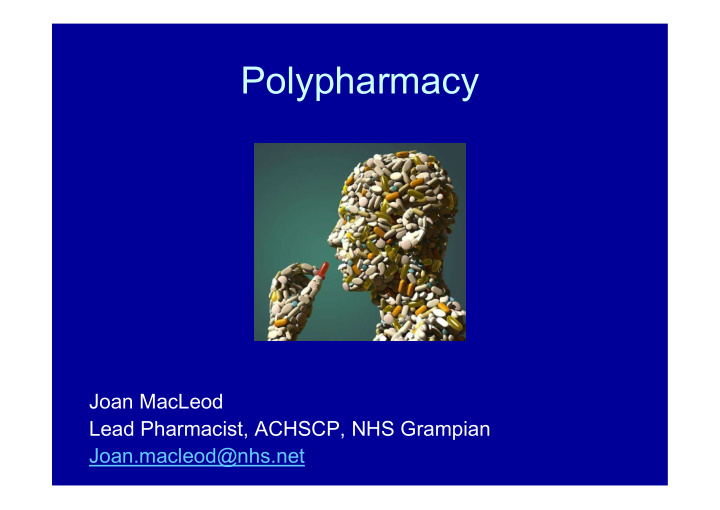



Polypharmacy Joan MacLeod Lead Pharmacist, ACHSCP, NHS Grampian Joan.macleod@nhs.net
Polypharmacy –what is it? • Phenomena of multiple medicine use • No one agreed definition in the academic literature • Generally considered to be the routine use of 4 or 5 medications at the same time • Appropriate v. problematic/inappropriate polypharmacy – Appropriate = medicines use has been optimised and prescribed according to best evidence – Problematic/inappropriate = multiple medication use is inappropriate, or where the intended benefit of the medication is not realized • 2 key issues with mediation – safety & efficacy
Scottish Guidance https://www.therapeutics.scot.nhs.uk/wp-content/uploads/2018/04/Polypharmacy-Guidance-2018.pdf https://www.gov.scot/publications/personalising-realistic-medicine-chief-medical-officer-scotland-annual-report-2017-2018/
Scottish Polypharmacy Definitions
Scale of the problem? Pictures taken from Scottish Polypharmacy Guidance
Time for a dilemma....... We prescribe drugs to improve quality of life and reduce mortality BUT Drugs can actually end up causing harm, reduce quality of life, and increase mortality
Review Process – individualised to the patient • Always about assessing the risks and benefits for that patient – which may change over time
Wider Considerations • Realistic Medicine • Numbers Needed to Treat (NNT) – The average number of patients who require to be treated for one to benefit compared with a control in a clinical trial. – The ideal NNT is 1, where everyone improves with treatment: the higher the NNT, the less effective is the treatment in terms of the trial outcome and timescale • Capacity and capability • Palliative care - Living Well/Dying Well • Frailty - ‘reduced ability to withstand illness without loss of function’ • Involvement of MDT
Other Issues…. • Medication burden – Need for blood tests/monitoring e.g. warfarin – Side effects, ADR e.g. statins – Complexity of routine/limitations e.g. furosemide • Willingness to adhere to regimen • Unpleasant taste/texture – using food/drink to mask/covert medication • Ability to swallow/chew – chewable tablets e.g. CaVitD – chewing of tablets (including EC/MR/SR preps) – choking/aspiration
Who to refer to/advise the patient to contact for review • GP practice for all clinical issues – Practice-attached pharmacist Pharmacy Technicians (ACHSCP) – GP – Aligned Geriatrician – Wider MDT • Community Pharmacist for any issues with oversupply, advice on management
Recommend
More recommend